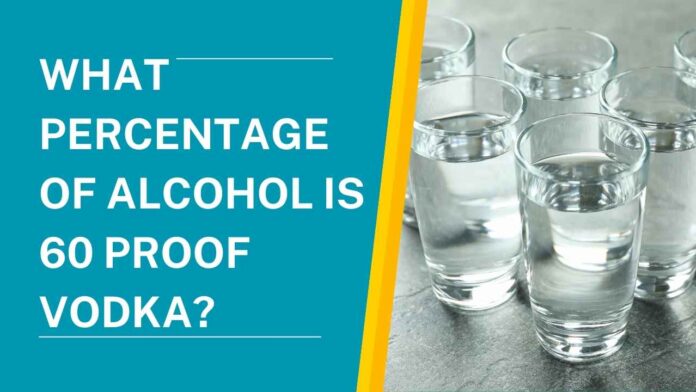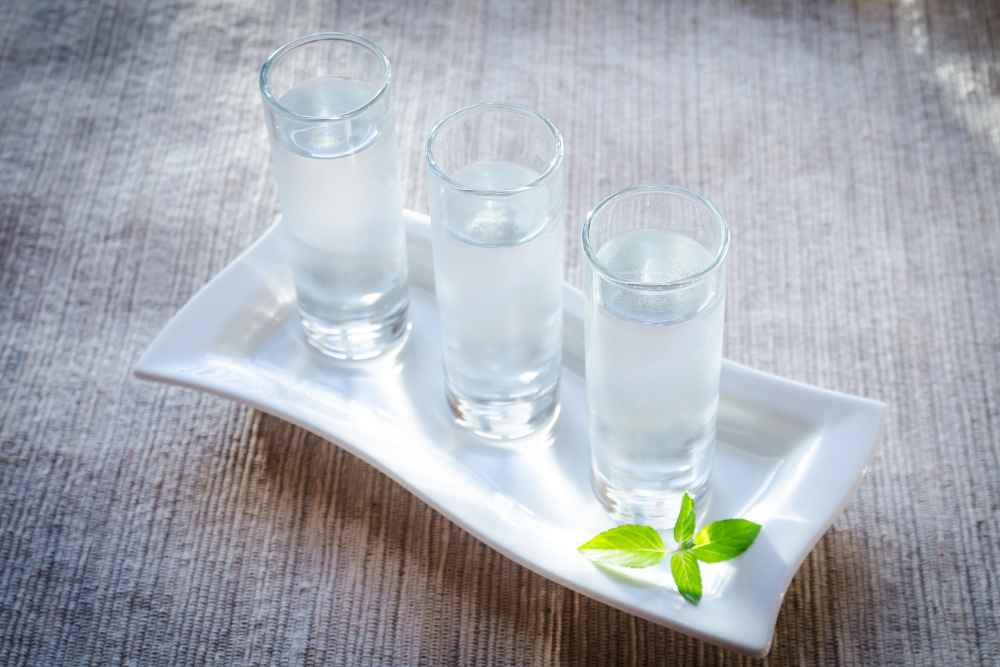This page may contain affiliate links. Please see our Disclaimer for more information. Always drink responsibly and adhere to your local legal drinking age.
Introduction
When it comes to enjoying a cocktail, understanding the alcohol content of your chosen beverage can be essential for responsible drinking.
One often confusing aspect is deciphering proof versus a percentage, particularly if you’re sipping on 60-proof vodka.
Key Takeaways:
- 60-proof vodka contains 30% alcohol by volume (ABV), which is lower than other high-proof liquors like rum, gin, and whiskey.
- To calculate the ABV percentage from a liquor’s proof, divide the proof by two. For 60-proof vodka, it would be 30% ABV.
- It’s essential to understand standard drink sizes and measurement units when consuming cocktails made with 60-proof vodka to drink responsibly and avoid health risks or legal consequences.
- Organic vodka is an option for people looking for a cleaner drinking experience without compromising taste. However, organic options may be more expensive than non-organic ones.
Understanding Alcohol Proof And Percentage
Alcohol proof is a measure of the strength or concentration of alcohol in an alcoholic beverage. In contrast, alcohol percentage, also known as ABV (alcohol by volume), measures the amount of pure ethanol present in a given volume of the drink.
Explanation Of Alcohol Proof
Alcohol proof serves as a way to measure the content of ethanol, or pure alcohol, in an alcoholic beverage.
Today’s method for determining alcohol proof is far more scientific but still involves some exciting math: In the United States, a liquor’s proof is simply double its percentage of alcohol by volume (ABV).
For example, a vodka labeled as 80-proof contains 40% ABV.
How Alcohol Percentage Is Measured
Alcohol percentage, often referred to as alcohol by volume (ABV), is a widely used measurement for ethanol concentration in an alcoholic beverage.
For example, if you have a cocktail that contains 2 ounces of vodka with an ABV of 40% mixed with 4 ounces of orange juice, the total amount of pure alcohol in your drink would be 0.8 ounces.
By dividing this value by the total liquid volume (6 ounces) and multiplying by 100, you’ll find that your cocktail has roughly 13% ABV. This simple calculation helps consumers understand how potent their drinks are, allowing them to make informed choices about consumption and pacing themselves throughout an evening out or at home.
What Does 60 Proof Vodka Mean?
60-proof vodka means that it contains 30% alcohol by volume, making it a lower alcohol content compared to other spirits.
Definition Of 60 Proof
In alcoholic beverages, “proof” is used to express the strength or concentration of alcohol in a drink. A 60-proof vodka contains 30% alcohol by volume (ABV), which makes it less potent than standard 80-proof vodka containing 40% ABV.
For cocktail enthusiasts seeking a milder kick, a 60-proof vodka could be an attractive option for their favorite mixed drinks. For instance, consider making a class Moscow Mule with this lower-proof spirit: combine one 60-proof vodka with three parts ginger beer and add fresh lime juice for tanginess.
The result would be a slightly gentler version of this popular cocktail without compromising its flavor profile.
How It Compares To Other Alcohol Types
Regarding alcohol strength, 60-proof vodka falls in the middle of the spectrum. To better understand how it compares to other alcohol types, here’s a table outlining some common beverages and their alcohol percentages:
| Alcohol Type | Alcohol Percentage (ABV) |
|---|---|
| 60 Proof Vodka | 30% |
| 80 Proof Vodka (standard) | 40% |
| Beer | 4-7% |
| Wine | 12-14% |
| Rum (80 proof) | 40% |
| Overproof Rum (151 proof) | 75.5% |
| Gin (80 proof) | 40% |
| Whiskey (80 proof) | 40% |
| Tequila (80 proof) | 40% |
As seen above, 60-proof vodka is less potent than 80-proof vodka and many other distilled spirits, such as rum, gin, whiskey, and tequila. However, it still has a higher alcohol percentage than beer and wine. This information is essential for cocktail drinkers when selecting their preferred beverage and enjoying alcohol responsibly.
How To Calculate Percentage Of Alcohol In 60-Proof Vodka
To calculate the alcohol percentage of 60-proof vodka, simply divide the proof by two; in this case, it would be 30% ABV.
Formula For Calculating Alcohol Percentage From Proof
To calculate the percentage of alcohol in 60-proof vodka, you can use a simple formula. Divide the proof by two to get the ABV percentage. So for 60 proof vodka, it would be 30% ABV (60 divided by two).
It’s important to note that different types of liquor have varying alcohol content. For example, gin or rum typically have a higher alcohol content than vodka.
Additionally, serving sizes and units of alcohol also play a role in the amount of alcohol consumed.
Examples
Here are some examples to help you understand the percentage of alcohol in 60-proof vodka:
- A standard shot of 60-proof vodka (1.5 ounces) contains 18% alcohol by volume or ABV.
- A cocktail with 1 ounce of 60-proof vodka and 4 ounces of mixer has an ABV of approximately 9%.
- A bottle of 60-proof vodka (750ml) contains 22.5 ounces of pure alcohol.
- If you mix equal parts (1 oz each) of 60-proof vodka and a liqueur with an ABV of 25%, the resulting drink will have an ABV of approximately 22.5%.
- Compared to other alcoholic beverages, beer typically has an ABV ranging from 3-10%, while wine ranges from around 12-16%.
Types Of Vodka
Vodka comes in various types, including flavored or unflavored and organic or non-organic – keep reading to learn more about the differences in each!
Flavored Vs. Unflavored
When choosing between flavored and unflavored vodka, it all boils down to personal preference. Flavored vodkas are infused with natural or artificial flavors like lemon, cucumber, vanilla, or even bacon! They tend to be 75 proof (35% ABV), which means they have slightly less alcohol content than standard 80 proof (40% ABV) unflavored vodka.
On the other hand, traditionalists prefer unflavored vodka as it has a higher alcohol content and can provide a stronger kick in cocktails. Unflavored vodka is often distilled from fermented grains or potatoes and must be bottled at not less than 30% alcohol by volume (60 proof) if flavored naturally.
Organic Vs. Non-organic
When it comes to vodka, there are two types that you might come across organic and non-organic. Organic vodka is made from organically grown grains or potatoes not treated with pesticides or other chemicals.
This means that the final product is free of synthetic substances, making it a healthier choice for some consumers.
One brand that offers an organic option is Ocean Organic Vodka, which uses deep ocean mineral water in its production process instead of tap water like many other brands.
While organic vodka may be a bit more expensive than its non-organic counterpart, it’s worth considering if you want a cleaner drinking experience without sacrificing taste.
Serving Sizes And Units Of Alcohol
The standard drink size for vodka is 1.5 ounces or a “shot,” which contains approximately 0.6 fluid ounces of pure alcohol. At the same time, different measurement units, such as milliliters and liters, are also used to measure alcohol consumption.
Standard Drink Size
Understanding standard drink sizes is important for anyone who drinks cocktails. A standard drink refers to a fixed amount of pure alcohol in different alcoholic beverages.
For instance, one 12-ounce beer, four ounces of wine, or 1-1/4 ounces of 80-proof distilled spirits like vodka, gin, or rum contain the same amount of pure alcohol. That’s around 0.6 ounces (14 grams), according to National Institute on Alcohol Abuse and Alcoholism (NIAAA).
Knowing what constitutes a standard drink will help you track your alcohol intake and make responsible drinking decisions.
Different Measurement Units
Alcohol content can be measured in different ways depending on where you are. As a cocktail drinker, knowing the different measurement units and what they mean is important. Here are some common units:
- ABV (alcohol by volume): This is the standard measurement used in most countries, including the US. It represents the percentage of alcohol in a beverage relative to its total volume.
- Proof: This is a measurement of alcohol content that originated in the UK and was adopted by the US. It is double the ABV percentage, so 60-proof vodka would be 30% ABV.
- Ounces: This unit measures the amount of pure alcohol in a drink based on its volume. A standard drink contains 0.6 ounces of alcohol.
By understanding these different units of measurement, you can better understand how much alcohol you’re consuming and make informed decisions about how much to drink to stay safe while enjoying your favorite cocktails. Remember, responsible drinking is key to having a good time without putting yourself or others at risk.
The Effects Of Alcohol On The Body
Alcohol affects the body in both short-term and long-term ways, from feeling tipsy to serious health risks – read on to learn more about safe consumption guidelines and the dangers of excessive alcohol consumption.
Short-term Effects
When drinking cocktails made with 60-proof vodka, it is important to understand the short-term effects of alcohol consumption. Here are some things you may experience:
- Relaxation and decreased inhibitions
- Slurred speech and impaired coordination
- Blurred vision and slower reaction times
- Increased heart rate and elevated blood pressure
- Nausea and vomiting in some cases
It’s important to remember that these effects can vary depending on your weight, tolerance, and the amount of alcohol consumed. Always drink responsibly and know your limits.
Long-term Effects
Excessive alcohol consumption can lead to long-term effects, including:
- Liver damage: Heavy drinking increases the risk of developing liver diseases such as cirrhosis, alcoholic hepatitis, and liver cancer.
- Heart disease: Alcohol abuse weakens the heart muscle, leading to an increased risk of high blood pressure, heart attack, and stroke.
- Cancer: Regular heavy consumption of alcohol is linked to an increased risk of developing several types of cancer, including breast, colon, and liver cancer.
- Mental health disorders: Long-term alcohol use can lead to depression, anxiety disorders, and dementia.
- Addiction: Prolonged alcohol use can lead to addiction or even alcohol dependence.
It’s important to be mindful of the effects that excessive alcohol consumption can have on your body in the long term. Moderation is key when enjoying cocktails and other alcoholic beverages to avoid these potential risks and maintain a healthy lifestyle.
Safe Consumption Guidelines
Always adhere to recommended limits for the safe consumption of alcohol, typically one standard drink per hour for men and women, and never operate a vehicle or machinery while under the influence.
Recommended Limits
It’s important to remember that consuming alcohol should always be done in moderation. For healthy adults, the recommended limits for drinking are no more than one drink per day for women and up to two drinks per day for men.
A standard drink of 80-proof vodka is approximately 1-1/4 ounces. It’s also recommended that individuals consume no more than seven drinks per week if they consume alcohol regularly.
However, exceeding these limits can increase the risk of serious health issues like liver disease, cancer, heart disease, and stroke.
Tips For Responsible Drinking
It’s important to enjoy your cocktails responsibly and avoid any negative consequences. Here are some tips for responsible drinking:
- Stick to a limit: Know your limits and stick to them. The recommended limit for women is one standard drink per day, while for men, it is two standard drinks per day.
- Alternate with water: Drinking water or non-alcoholic beverages between each alcoholic drink can help you stay hydrated and pace your consumption.
- Eat before drinking: Eating a meal before drinking can slow down the absorption of alcohol into your bloodstream and reduce the effects of intoxication.
- Avoid binge drinking: Binge drinking is defined as consuming four or more drinks for women or five or more for men in about 2 hours. This can lead to serious health risks, including alcohol poisoning.
- Don’t drink and drive: Never operate a vehicle after consuming alcohol. It’s illegal and extremely dangerous.
By following these tips, you can enjoy your cocktails safely and responsibly without putting yourself or others at risk from excessive alcohol consumption. Remember, moderation is key!
Risks And Dangers Of Excessive Alcohol Consumption
Excessive alcohol consumption can lead to physical and mental health risks and legal consequences such as drinking and driving. It is important to understand the safe consumption guidelines and tips for responsible drinking.
Physical And Mental Health Risks
Drinking alcohol can have both short-term and long-term effects on the body and mind. Here are some physical and mental health risks associated with excessive alcohol consumption:
- Increased risk of liver diseases, such as cirrhosis and fibrosis.
- Higher likelihood of developing certain types of cancer, including breast, colon, and liver.
- Elevated blood pressure and increased risk of heart disease or stroke.
- Impaired cognitive function, memory loss, and brain damage.
- Mental health problems such as depression, anxiety, and insomnia.
- Increased risk of accidents and injuries due to impaired judgment and coordination.
- Alcohol poisoning, which can lead to coma or death in severe cases.
It’s important to remember that while moderate alcohol consumption may not have negative health effects for many people, excessive drinking can harm your physical and mental well-being over time.
Legal Consequences Of Drinking And Driving
If you choose to drink and drive, the consequences can be severe. Driving under the influence (DUI) is a criminal offense in most states that can lead to fines, license suspension or revocation, imprisonment, and even death.
In California and New Jersey, for instance, a blood alcohol concentration (BAC) of 0.08 percent or greater is considered legally impaired driving.
Moreover, the effects of mild alcohol consumption don’t just stay with you when driving but also put you at risk for other types of accidents outside of drunk-driving incidents, such as sports injuries due to reduced balance while playing games like soccer or basketball, falls due to reduced coordination while walking up stairs or escalators; and burns from decreased reaction times around hot appliances like stovetops or grills.
FAQ
Q: What is 60-proof vodka, and what is its alcohol content?
A: 60-proof vodka is a type of liquor that contains 30% alcohol by volume (ABV) or 40% alcohol by weight. It’s a popular alcoholic beverage that can be enjoyed independently or used as a base for cocktails and other mixed drinks.
Q: How does 60-proof vodka compare to other types of liquor in terms of alcohol content?
A: 60-proof vodka is considered a relatively low-proof alcohol compared to other liquors. For example, 100-proof alcohol contains 50% ABV, while Everclear, a high-proof spirit, contains up to 95% ABV.
Q: Is 60-proof vodka the same as 30% alcohol?
A: Yes, 60-proof vodka contains 30% ABV, which is the same as saying 60-proof.
Q: Is 60-proof vodka considered to be a high-proof alcohol?
A: No, 60-proof vodka is not considered high-proof alcohol. High-proof spirits are generally those with an ABV of 50% or higher.
Q: Can you drink 60-proof vodka straight or on the rocks?
A: Yes, you can drink 60-proof vodka straight or on the rocks, although some people may prefer to mix it with other ingredients or use it as a base for cocktails.
Q: How do you measure the alcohol content of 60-proof vodka?
A: Alcohol content can be measured using the proof system, which measures the percentage of alcohol in a beverage. 60-proof vodka contains 30% ABV, which is 60-proof.
Q: What is the highest-proof alcohol?
A: The highest-proof alcohol available for purchase is Spirytus, a Polish vodka that contains 96% ABV or 192 proof.
Q: What is the difference between 60-proof vodka and 90-proof vodka?
A: 90-proof vodka contains a higher ABV of 45% compared to the 30% ABV of 60-proof vodka. This means 90-proof vodka is stronger and may have a more potent flavor than 60-proof vodka.
Q: Can you use 60-proof vodka in place of other types of liquor when making a cocktail?
A: Yes, 60-proof vodka can be used as a substitute for other types of liquor in cocktails, although it may change the drink’s flavor compared to using a different type of liquor with a different ABV.
Q: What is the percentage of ethanol in 60-proof vodka?
A: The percentage of ethanol in 60-proof vodka is 30% or 40% by weight.
Conclusion: Understanding Alcohol Percentage And Proof In 60 Proof Vodka
In conclusion, understanding the alcohol percentage and proof in 60 Proof Vodka is essential for any cocktail enthusiast. As we’ve learned, 60 Proof Vodka contains 30% alcohol by volume, which is lower than other high-proof liquors such as whiskeys and rums.
By knowing how to calculate the percentage of alcohol from proof, you can make informed decisions regarding serving sizes and responsible drinking.





















